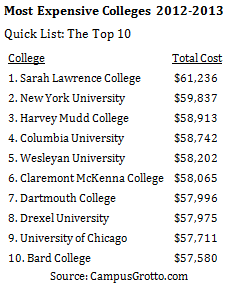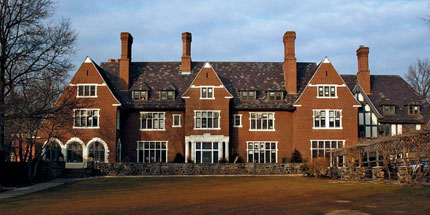
A new era is upon us, and while its not quite the end of the world, it sure feels like it when the sticker shock hits the pocketbooks of those sending their kids to college.
Its not just the college-bound that are feeling the pinch, an increasing number of past borrowers are struggling to pay. The current default rate on federal student loans stands at 13.4% for the first three years that students are required to make payments, the highest level in 14 years.
Colleges have jacked up costs high enough for student debt to top $1 trillion.
Unless something changes, its only going to get worse. At this rate well be seeing $130,000 a year colleges by 2030.
Between costs approaching $60,000 a year, an increase in student loan defaults and over $1 trillion in student loan debt, it's clear that the current model of raising tuition every year (at a rate higher than inflation) is unsustainable.
College costs began to increase at a rate faster than inflation in the early 1980s. This has been a continuing trend: 74 colleges now charge over $55,000 per year. (Just 19 did last year and only one the year before that.)
Most Expensive Colleges for 2012-2013

This is the 6th annual Most Expensive Colleges ranking compiled by CampusGrotto.com. The significance of this years ranking is that it is the first year a college has passed the $60K/year mark in total cost.
Sarah Lawrence College is once again named Americas most expensive college, marking the 5th year in a row it has topped the ranking.
One school on the list, Mount Holyoke College, had their price remain the same as last year thanks in part to a tuition freeze. This is the first time since 1968 that the college has not increased the cost of attendance and was enough to drop the school 33 spots to #94 on the most expensive list. It will be interesting to see if we see more of these tuition freezes in the coming years.
The price tags shown for these institutions do not mean that these schools are financially out of reach.
Just because these schools have high tuition does not mean you will actually be paying that amount. Many schools will provide a financial aid package that meets 100% of a student's financial need (Cost of Attendance - Estimated Family Contribution). While going to college is still expensive, many of the colleges here offer excellent financial aid packages. Some colleges, like Brown University, even eliminate tuition altogether for lower income students. (It is the middle class who are seeing financial difficulties in paying for college.)
To get a better understanding of what you will actually be paying, be sure to use the net price calculator that each school provides on their website. These typically take about 10-15 minutes to complete, but can provide a more realistic ballpark figure of what you can expect to pay. (For a complete list of colleges and links to their net price calculators visit NetPriceCalculator.com.)
We start by taking a look at tuition and fees that are required of all undergraduates.
Highest Tuition and Fees for 2012-2013
| College | Tuition & Fees |
| 1. Columbia University | $47,246 |
| 2. Sarah Lawrence College | $46,924 |
| 3. Vassar College | $46,270 |
| 4. The George Washington University | $45,780 |
| 5. Trinity College (CT) | $45,730 |
| 6. Wesleyan University | $45,628 |
| 7. Carnegie Mellon University | $45,554 |
| 8. Bucknell University | $45,378 |
| 9. Tulane University | $45,240 |
| 10. Union College (NY) | $45,219 |
Room and board is another cost that is often overlooked. Where the school is located plays a big factor in rooming costs. Here we add the typical cost of room and board charged at each college giving us the total billable cost of attendance. In addition, students should anticipate for textbooks, supplies, personal expenses and transportation costs (not included in these prices).
Most Expensive Colleges 2012-2013
| College | Total Cost |
| 1. Sarah Lawrence College | $61,236 |
| 2. New York University | $59,837 |
| 3. Harvey Mudd College | $58,913 |
| 4. Columbia University | $58,742 |
| 5. Wesleyan University | $58,202 |
| 6. Claremont McKenna College | $58,065 |
| 7. Dartmouth College | $57,996 |
| 8. Drexel University | $57,975 |
| 9. University of Chicago | $57,711 |
| 10. Bard College | $57,580 |
| 11. Trinity College (CT) | $57,530 |
| 12. Eugene Lang College (The New School) | $57,340 |
| 13. Johns Hopkins University | $57,320 |
| 14. Barnard College | $57,312 |
| 15. Pitzer College | $57,266 |
| 16. Bates College | $57,235 |
| 17. Fordham University - Lincoln Center | $57,188 |
| 18. Northwestern University | $57,108 |
| 19. Fordham University - Rose Hill | $57,106 |
| 20. Carnegie Mellon University | $57,104 |
| 21. Cornell University | $57,091 |
| 22. Scripps College | $57,088 |
| 23. Vassar College | $57,070 |
| 24. Occidental College | $57,028 |
| 25. Oberlin College | $57,025 |
Total Cost = Tuition + Room & Board + Required Fees
Data compiled by CampusGrotto.com
Upcoming:
The Most Expensive College Dorms
To get this, subscribe by email.
Notable Press:
CNBC
Yahoo! Finance
ABC News and affiliates
CBS
More
Notes:
Total Cost = Tuition + Room and Board + Required Fees
The fees included in the total cost only include fees that are required for all undergraduates. These fees typically include items like the Student Activity Fee, a Facilities Fee, and a Technology fee. You won't see any fees by major, orientation fees for incoming students, or medical insurance fees included in these costs. Many other fees can be optional and can vary per student and per major. A Student Health Insurance Fee, for example, is obviously not going to be required for a student already on their parents insurance plan. Some colleges have their yearly budget for students listed slightly higher than what you see here. This is because some colleges also add in estimated costs of books, personal expenses, and transportation costs.
Tuition numbers were taken directly from each college's website during the last week in September of 2012.
This list only takes into account colleges that offer bachelor's (BA) degrees, so you will not see schools like Landmark College (costs over $55K) who only offer students an Associate of Arts (AA) degree. These prices are for traditional 4-year undergraduate colleges, so no Junior Colleges or Music Conservatories are included.